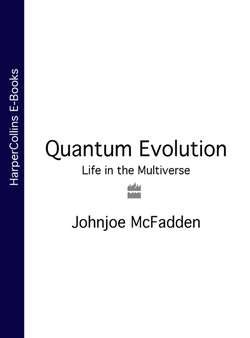Читать книгу Quantum Evolution: Life in the Multiverse - Johnjoe McFadden - Страница 25
HOW DNA TELLS THE CELL WHAT TO DO
ОглавлениеDNA encodes proteins but doesn’t make them. That job is performed by structures inside cells called ribosomes which stitch together single amino acid units into strings which are called peptides if short, proteins if they are long. Left to their own devices, ribosomes might randomly string together amino acids, making totally random proteins. Ribosomes could make a staggering variety of proteins if allowed to function in this manner. Consider a relatively small protein, say only one hundred amino acids long. For each of the hundred positions in the protein there are twenty possible amino acids that could be inserted. There are therefore 20100 different ways of putting such a protein together. 20100 is an immense number. It means the product of 20 x 20 x 20 x 20 x 20 x 20 x … 100 times. For convenience, big numbers like this are usually expressed as a power of 10, so that they can easily be compared. In this system, 20100 can also be written as 10130. For comparison, the number of electrons in the universe is a much smaller number, about 1080, so there are not even enough electrons in the entire universe to count the number of possible 100 amino acid proteins! The ribosome’s task is to make only a very tiny fraction of these possible proteins – the proteins the cell needs.
The problem is similar to house-building. The number of possible ways of putting several thousand bricks together is again a staggeringly large number and only a tiny fraction would amount to a functional house. The builder must select from the vast number of possible piles of bricks, one that corresponds to the desired house. He uses a plan that maps each brick (in principle if not in practice) to a specific position in space. The plan provides the builder with the information he needs to build the house. Similarly, the living cell must select from the vast number of all possible proteins the tiny fraction that corresponds to proteins with useful functions. The cell similarly needs to have some kind of plan or template and for this it uses DNA.
There is, however, (at least in animal and plant cells) a physical problem that must be overcome if DNA is to direct protein synthesis. DNA is held within the nucleus (a membrane-bound sac inside cells) of animal cells but the ribosomes are located outside it in the cytoplasm (the cellular material outside the nucleus). One possible solution would be for the DNA to pass through the nuclear membrane to the ribosomes where it is needed to direct protein synthesis. However DNA is a huge molecule, millions or even billions of bases long and it would not be easy for it to squeeze out through the membrane’s small pores. What actually happens is that the information held in DNA is copied into a smaller, mobile analogue of DNA, known as RNA. RNA has all the same bases as DNA (well nearly all, it uses a base called uracil instead of thymine) on a sugar phosphate backbone, just like DNA. The only difference is that the sugar that goes into its backbone is ribose rather than deoxyribose (hence RNA rather than DNA). Since the bases are nearly the same, a single DNA strand can pair with a complementary RNA strand (the RNA uracil pairs with adenine) to form a DNA::RNA hybrid double helix. An enzyme called RNA polymerase then makes RNA copies of DNA genes. The RNA copy, called messenger RNA or simply mRNA is usually only one to several thousand bases long and can easily travel out through the pores in the nuclear membrane to reach a ribosome. It then locks into the machinery and tells the ribosome which protein to make.
The linear mRNA molecule is fed into a cleft within the ribosome which, acting like a barcode reader, reads the mRNA code, a codon at a time. The ribosome also has a docking station for amino acids. The ribosomes are, however, unable to identify or incorporate naked amino acids. Instead, each amino acid has to be tagged with yet another type of RNA molecule called transfer RNA or simply tRNA. Each tRNA molecule carries a three base anticodon sequence that acts as a complementary barcode to identify the amino acid it carries. All the ribosome has to do is to pair up the two barcodes – the codon on mRNA with the anticodon on tRNA – and thereby insert the correct amino acid. The mRNA molecule is fed into the ribosome, a codon at a time, and at each step, the appropriate amino acid is clipped off the tRNA molecule and attached to the growing amino acid chain.
